People Power Revolution
The People Power Revolution, also known as the EDSA Revolution[Note 1] or the February Revolution,[4][5][6][7] was a series of popular demonstrations in the Philippines, mostly in Metro Manila, from February 22 to 25, 1986. There was a sustained campaign of civil resistance against regime violence and electoral fraud. The nonviolent revolution led to the departure of Ferdinand Marcos, the end of his 20-year dictatorship and the restoration of democracy in the Philippines.
| People Power Revolution | |||
|---|---|---|---|
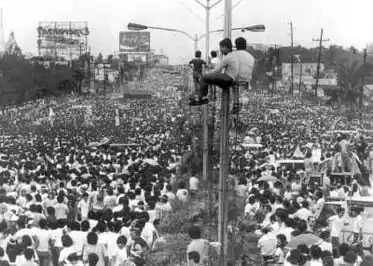 Hundreds of thousands of people filling up Epifanio de los Santos Avenue (EDSA), facing northbound towards the Boni Serrano Avenue–EDSA intersection (February 1986) | |||
| Date | February 22–25, 1986 (3 days) | ||
| Location | Philippines, primarily Epifanio de los Santos Avenue, Metro Manila | ||
| Caused by |
| ||
| Goals |
| ||
| Resulted in | Opposition victory
| ||
| Parties to the civil conflict | |||
| |||
| Lead figures | |||
| |||
| Number | |||
| |||
| History of the Philippines |
|---|
 |
| Timeline |
|
|
| ||
|---|---|---|
Presidency
First term
Second term
Martial law
Third term
Family
Unexplained wealth
Related
|
||
| ||
| Part of a series on |
| Revolution |
|---|
 |
|
|
It is also referred to as the Yellow Revolution[8] due to the presence of yellow ribbons during demonstrations (in reference to the Tony Orlando and Dawn song "Tie a Yellow Ribbon Round the Ole Oak Tree") as a symbol of protest following the assassination of Filipino senator Benigno "Ninoy" Aquino, Jr.[9] in August 1983 upon his return to the Philippines from exile. It was widely seen as a victory of the people against two decades of presidential rule by President Marcos, and made news headlines as "the revolution that surprised the world".[10]
The majority of the demonstrations took place on a long stretch of Epifanio de los Santos Avenue, more commonly known by its acronym EDSA, in Metro Manila from February 22 to 25, 1986. They involved over two million Filipino civilians, as well as several political and military groups, and religious groups led by Cardinal Jaime Sin, the Archbishop of Manila, along with Catholic Bishops' Conference of the Philippines President Cardinal Ricardo Vidal, the Archbishop of Cebu. The protests, fueled by the resistance and opposition from years of governance by President Marcos and his cronies, culminated with the ruler and his family fleeing Malacañang Palace to be forced exiled with the help of the US by flying the family away from the Philippines and to Hawaii. Ninoy Aquino's widow, Corazon Aquino, was immediately installed as the eleventh president as a result of the revolution.[11]
Background and history
President Ferdinand E. Marcos was elected president in 1965, defeating incumbent President Diosdado Macapagal by a margin of 52 to 43 percent. During this time, Marcos was very active in the initiation of public works projects and the intensification of tax collections. Marcos and his government claimed that they "built more roads than all his predecessors combined and more schools than any previous administration".[12] Amidst charges from the opposition party of vote-buying and a fraudulent election, President Marcos was reelected in the 1969 Philippine presidential election, this time defeating Sergio Osmeña, Jr. by 61 to 39 percent.
President Marcos's second term for the presidency was marred by allegations by the opposition Liberal Party of widespread graft and corruption. According to leftists who rioted during the First Quarter Storm, the increasing disparity of wealth between the very wealthy and the very poor that made up the majority of the Philippines' population led to a rise in crime and civil unrest around the country. In March 1969, the New People's Army (NPA) was formed as the military wing of the Communist Party of the Philippines, initiating the still-ongoing CPP–NPA–NDF rebellion. Marcos quickly denounced the movement, hoping to gain monetary and political support from anti-Communist administrators in the United States.[13]
In 1972 the Moro National Liberation Front, a militant Muslim separatist group, formed in the southern island of Mindanao.[14]
Marcos soon used the rise of militant and civil unrest as justification for declaring martial law.
Martial law
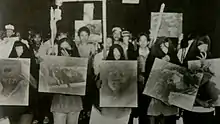
Barred from running for a third term as president in 1973, Marcos announced Proclamation No. 1081 on September 23, 1972, declaring martial law,[15] using the civil unrest that arose after the 1969 Philippine balance of payments crisis as a justification for the proclamation.[16]
Through this decree and through a controversial referendum in which citizen assemblies voted through a show of hands, Marcos seized emergency powers giving him full control of the Philippines' military and the authority to suppress and abolish the freedom of speech, the freedom of the press, and many other civil liberties.
President Marcos also dissolved the Philippine Congress and shut down media establishments critical of the Marcos Administration.[16] He also ordered the immediate arrest of his political opponents and critics. Among those arrested were Senate President Jovito Salonga, and the leaders Senator Jose W. Diokno and Senator Benigno Aquino Jr. — whom Marcos sent to Laur, Nueva Ecija[17] — and the man who was groomed by the opposition to succeed President Marcos after the 1973 elections.[16]
A constitutional convention, which had been called for in 1970 to replace the Commonwealth-era 1935 Constitution, continued the work of framing a new constitution after the declaration of martial law. The new constitution went into effect in early 1973, changing the form of government from presidential to parliamentary and allowing President Marcos to stay in power beyond 1973. The constitution was approved by 95% of the voters in the Philippine constitutional plebiscite. The constitution was part of the landmark Javellana v. Executive Secretary case (G.R. No. 36142) that led to the resignation of Chief Justice Roberto Concepcion. Part of the plot of the regime involved legitimizing the military rule through the new constitution providing legislative and executive powers to the president. Simultaneously Marcos conducted the 1973 plebiscite through the simple counting of hands raised by children and adults that involved questions such as the option for more rice in lieu of constitutional affirmation.[18]
With practically all of his political opponents arrested, out of office, and in exile, President Marcos's pre-emptive declaration of martial law in 1972 and the ratification of his new constitution by more than 95% of voters enabled Marcos to effectively legitimize his government and hold on to power for another 14 years beyond his first two terms as president. In a Cold War context, Marcos retained the support of the United States through Marcos's promise to stamp out communism in the Philippines and by assuring the United States of its continued use of military and naval bases in the Philippines.[16]
On November 27, 1977, a military tribunal sentenced Aquino and two co-accused, NPA leaders Bernabe Buscayno (Commander Dante) and Lt. Victor Corpuz, to death by firing squad.[19] In 1978, while still the last opposition leader yet to be released from prison at Fort Bonifacio, Aquino founded his political party, Lakas ng Bayan (abbreviated "LABAN"; English: People's Power) to run for office in the Interim Batasang Pambansa (Parliament). All LABAN candidates lost, including Aquino himself. He appeared in a television interview with Ronnie Nathanielsz to freely criticize the regime during the campaign. In 1980, he was later released to have a heart operation in the United States, being banned from repatriating back to the Philippines. Aquino had successful surgery in Dallas and then moved east.[20] Aquino stayed with his wife Corazon, and children in Boston College as a fellow for numerous American universities such as Harvard and the Massachusetts Institute of Technology.
Assassination response, economic upheaval, and formation of coalesced opposition
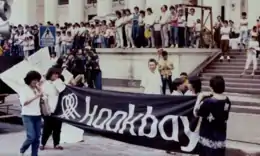
Despite warnings from the military and First Lady Imelda Marcos, Ninoy Aquino was determined to return home. Asked what he thought of the death threats, Aquino responded, "The Filipino is worth dying for."[21] Ninoy's passport expired and the renewal was denied. Ninoy developed a plan to acquire a passport with the help of Rashid Lucman.[22] The passport carried the alias Marcial Bonifacio (Marcial for martial law and Bonifacio for Fort Bonifacio where he was imprisoned).[23]
On August 21, 1983, after three years, Aquino was murdered by the military,[24] as he disembarked from a plane at the Manila International Airport (later renamed in Aquino's honor).[25] His assassination shocked and outraged most Filipinos, who had lost confidence in the Marcoses. The event led to more suspicions about the government, triggering non-cooperation among Filipinos that eventually led to outright civil disobedience.[26] It also shook the Marcos Administration, which was by then deteriorating due in part to Marcos's blatant illness (turned out to be the fatal lupus erythematosus).
By the end of 1983, the economy contracted by 6.8%.[27] Because the Marcos administration's spending had relied so heavily on debt since the Marcos family's first term in the 1960s,[28] the Philippines was left vulnerable when the US economy went into recession in the third quarter of 1981, forcing the Reagan administration to increase interest rates.[29] The Philippine government plunged further into debt and the economy began going into decline in 1981, continuing to do so by the time of the Benigno Aquino Jr. assassination in 1983. The economic and political instability combined to produce the worst recession in Philippine history in 1984 and 1985, with the economy contracting by 7.3% for two successive years.[29][28][30][31][32]
In 1984, Marcos appointed a commission, first led by Chief Justice Enrique Fernando and later Corazon Agrava, to launch an investigation into Aquino's assassination. Despite the commission's conclusions, Cardinal Jaime Sin, the Archbishop of Manila, declined an offer to join the commission and rejected the government's views on the assassination.
This began a period of coalitions, first led by the nationalist liberal democrats under Jose W. Diokno called Kilusan sa Kapangyarihan at Karapatan ng Bayan or KAAKBAY, an umbrella organization founded in 1983, which headed the first grand liberal coalition called JAJA, or the Justice for Aquino, Justice for All movement. JAJA consisted of organizations such as the social democrat-based August Twenty One Movement (ATOM) led by Butz Aquino, KAAKBAY, MABINI, the Makati-based Alliance of Makati Associations or AMA, and others. Parliamentarians of the streets, as it was called applied pressure politics, and soon other coalitions were formed, culminating in the first call for elections for the opposition in the Kongreso ng Mamamayang Pilipino or KOMPIL.[33] KOMPIL was organized by Aquino's ATOM from the JAJA coalition, as a means to unite the businessmen, communists, and other groups. Most of the KOMPIL members were led by the AMA leaders. Meanwhile Diokno, Lorenzo M. Tañada of MABINI, Butz and Corazon Aquino, and a few others were elected the overall presiding leaders in a search to find the opposition candidate. The main issue was whether to accept the CAMEL or Call for Meaningful Elections or, as Diokno and the more liberal JAJA members preferred, to boycott the event which might be another fixed election.[34] JAJA was later replaced by the Coalition of Organizations for the Restoration of Democracy (CORD) in the middle of 1984, which retained most of JAJA’s features and membership. A year later CORD was replaced by Bagong Alyansang Makabayan or BAYAN, which was to be a platform for Diokno should he run for president, and was led by Tañada and student leader Lean Alejandro of the University of the Philippines. However the socialists/national democrats took control of the coalition so Diokno, Ambrosio Padilla, and the liberal democrats as well as Butz Aquino, ATOM, and the social democrats left BAYAN to the present national democratic coalition that it has become in the 21st century.[35] Before the division of the center-left and national democratic/Marxist left, the coalitions tended to pursue Diokno's philosophy of pressure politics or mass actions to influence and sway the Marcos dictatorship.[36]
CAMEL
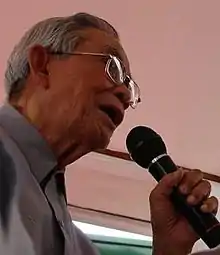
Eventually the top leaders decided to convene to select a candidate in case of contingencies or any sudden announcements of changes. It was then on November 3, 1985, after pressure from the US government,[37] that Marcos suddenly announced a snap presidential election would take place the following year, one year ahead of the regular presidential election schedule, to legitimize his control over the country.[38] The snap election was legalized with the passage of Batas Pambansa Blg. 883 (National Law No. 883) by the Marcos-controlled unicameral congress called the Regular Batasang Pambansa.[39]
To select a leader, the convenor's group of opposition leaders formed underlying principles. These principles, mainly proposed and edited by Diokno, discussed matters that involved anti-foreign domination in the economy, especially American intervention and military bases.[40] After the principles were agreed upon by the opposition leaders, as Lorenzo M. Tañada quipped, it became almost automatic and completely expeditious in agreeing unanimously on one candidate to face Marcos. For the initial step in nominating a candidate, the selection process started out with a pooled list among the opposition leaders themselves. The list of candidates for president were mostly including former senators: Jose W. Diokno, Butz Aquino, Jovito Salonga, Eva Estrada-Kalaw, Salvador "Doy" Laurel, Ambrosio Padilla, Aquilino Pimentel, Raul Manglapus, and Ramon Mitra, as well as a future senator in Teofisto Guingona Jr., and a technocrat who once served as Marcos's executive secretary named Rafael Salas.[41]
After the vetting of nominees, as men such as Sen. Diokno vehemently opposed to run for president,[42] the remaining potential candidates who openly wished to earn the opposition's nomination were Salonga, Laurel, and Estrada-Kalaw. United Nationalist Democratic Organization (UNIDO) members Estrada-Kalaw and Laurel were the only two not to sign the declaration of unity or the underlying principles. Eventually Estrada-Kalaw withdrew after being overwhelmed by the multiple candidates in the selection process and campaigned to become the vice-presidential candidate.[43] Between 64 year old Salonga, who with 64 year old Estrada-Kalaw represented the two largest Liberal Party factions, and Laurel, who was son of former president Jose P. Laurel, it was decided by men such as Chino Roces that both candidates might lack the popularity needed to win.[44] This was because Salonga had spent much time in exile in the United States while Laurel, the founder and main head of UNIDO, was deemed "too lightweight".[42]
UNIDO and the other coalitions agreed to choose Aquino's wife Cory Aquino instead of Luarel or Estrada-Kalaw and began the Cory Aquino for President Movement or CAPM, led by Roces, et al. Only Laurel, a friend of Ninoy Aquino, did not agree with this choice and wanted to run against Aquino and Marcos. UNIDO overwhelmed Laurel's vote and encouraged him to become Cory Aquino's vice-president instead. Once Cory Aquino became the main candidate, Laurel eventually ran as Cory Aquino's running mate for vice-president under the United Opposition (UNIDO) party. Marcos ran for re-election, with Arturo Tolentino as his running mate under the Kilusang Bagong Lipunan (KBL) party.[39] Thus within a matter of only a few weeks the candidates were fixed and the campaign period was set for the 1986 snap election.
1986 election
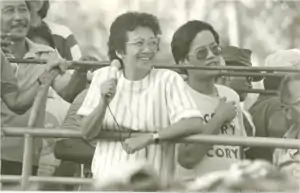
The election was held on February 7, 1986.[38] The official election canvasser, the Commission on Elections (COMELEC), declared that Marcos was the winner. The final tally of the COMELEC had Marcos winning with 10,807,197 votes against Aquino's 9,291,761 votes. On the other hand, based on returns of 70% of the precincts[45] of the National Movement for Free Elections (NAMFREL), an accredited poll watcher, had Aquino winning with 7,835,070 votes against Marcos's 7,053,068 votes.[46]
This electoral exercise was marred by widespread reports of violence and tampering of election results, culminating in the walkout of 30 COMELEC computer technicians to protest the deliberate manipulation of the official election results to favor Ferdinand Marcos. The walkout was considered one of the early "sparks" of the People Power Revolution. The walkout also served as an affirmation to allegations of vote-buying, fraud, and tampering of election results by the KBL.[47][48]
Because of reports of alleged fraud, the Catholic Bishops' Conference of the Philippines (CBCP) through Cardinal Ricardo Vidal issued a statement condemning the elections.[49] The United States Senate also passed a resolution stating the same condemnation.[38] US president Ronald Reagan issued a statement calling the fraud reports as "disturbing" but he said that there was fraud "on both sides" of the Philippine election.[50][51] In response to the protests, COMELEC claimed that Marcos with 53 percent won over Aquino. However, NAMFREL countered that the latter won over Marcos with 52 percent of votes.[52]
On February 15, Marcos was proclaimed by COMELEC and Batasang Pambansa as the winner amid the controversy. All 50 opposition members of the Parliament walked out in protest. The Filipino people repudiated the results, asserting that Aquino was the real victor. Both "winners" took their oath of office in two different places, with Aquino gaining greater mass support. Aquino also called for coordinated strikes and mass boycott of the media and businesses owned by Marcos's cronies. As a result, the crony banks, corporations, and media were hit hard, and their shares in the stock market plummeted to record levels.[53]
Vidal's declaration
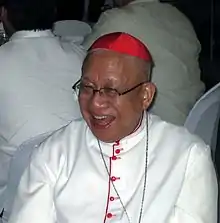
Cardinal Vidal, after the result of the snap election, issued a declaration in lieu of the Philippine Church hierarchy stating that when "a government does not of itself freely correct the evil it has inflicted on the people then it is our serious moral obligation as a people to make it do so." The declaration also asked "every loyal member of the Church, every community of the faithful, to form their judgment about the February 7 polls" and told all the Filipinos, "Now is the time to speak up. Now is the time to repair the wrong. The wrong was systematically organized. So must its correction be. But as in the election itself, that depends fully on the people; on what they are willing and ready to do."[49]
Events
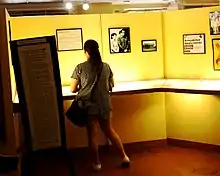
Civil disobedience and boycott campaign launch
On February 16, 1986, Corazon Aquino held the "Tagumpay ng Bayan" (People's Victory) rally at Luneta Park, announcing a civil disobedience campaign and calling for her supporters to boycott publications and companies which were associated with Marcos or any of his cronies.[54] The event was attended by a crowd of about two million people.[55] Aquino's camp began making preparations for more rallies, and Aquino herself went to Cebu to rally more people to their cause.[56]
Aborted military coup
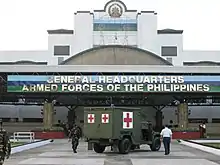
In the aftermath of the election and the revelations of irregularities, the Reform the Armed Forces Movement (RAM) - a cabal of officers of the Armed Forces of the Philippines (AFP) disgruntled by the patronage politics and corruption in the AFP, formed in 1982[57] - set into motion a coup attempt against the Ferdinand and Imelda Marcos.[58]
RAM's initial plan was for a team to assault Malacañang Palace and arrest Ferdinand Marcos. RAM founder Col. Gringo Honasan formulated a plan to attack the palace and "neutralize" the Marcos couple.[59] Other military units would take over key strategic facilities, such as the airport, military bases, the GHQAFP in Camp Aguinaldo, and major highway junctions to restrict counteroffensive by Marcos-loyal troops.
However, after Marcos learned about the plot, he ordered their leaders' arrest,[60] and presented to the international and local press some of the captured plotters, Maj. Saulito Aromin and Maj. Edgardo Doromal.[61]
Threatened with their impending imprisonment, Defense Minister Juan Ponce Enrile and his fellow coup plotters decided to ask for help from then-AFP Vice Chief of Staff Lt. Gen Fidel Ramos, who was also the chief of the Philippine Constabulary (now the Philippine National Police). Ramos agreed to resign from his position and support the plotters. Ramos also contacted the highly influential Cardinal Archbishop of Manila Jaime Sin for his support.[62]
Despite Ramos' defection, however, the coup plotters were essentially trapped in Camp Crame, and in the words of historian Vicente L. Rafael, "became sitting ducks for Ferdinand Marcos’ loyalist forces."[63]
At about 6:30 p.m. on February 22, Enrile and Ramos held a press conference at the Ministry of National Defense building in Camp Aguinaldo, the AFP headquarters, where they announced that they had resigned from their positions in Marcos' cabinet and were withdrawing support from his government. Marcos himself later conducted a news conference calling on Enrile and Ramos to surrender, urging them to "stop this stupidity".[64] Marcos tried to call Enrile, but Enrile refused to play Marcos's game. Eventually out of desperation Marcos televised his sickly appearance, and announced that he promises to crush every Filipino who stands in his way in order to capture Enrile and Ramos.[62]
Cardinal Sin's appeal
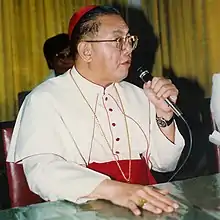
After Cardinal Vidal's condemnation of the snap election's fraudulent result, a message was aired over Radio Veritas at around 9 p.m., Cardinal Sin exhorted Filipinos in the capital to aid rebel leaders by going to the section of EDSA between Camp Crame and Aguinaldo and giving emotional support, food and other supplies. For many, this seemed an unwise decision since civilians would not stand a chance against a dispersal by government troops. Many people, especially priests and nuns, still trooped to EDSA.[64]
My Dear People, I wish you to pray, because it's only through prayer that we may solve this problem. This is Cardinal Sin speaking to the people, especially in Metro Manila. I am indeed concerned about the situation of Minister Enrile and General Ramos, I am calling our people to support our two good friends at the camp. If any of you could be around at Camp Aguinaldo to show your solidarity and your support in this very crucial period, when our two good friends have shown their idealism, I would be very happy if you support them now. I would only wish that violence and bloodshed be avoided. Let us pray to our blessed lady to help us in order that we can solve this problem peacefully
Radio Veritas played a critical role during the mass uprising. Former University of the Philippines president Francisco Nemenzo stated that: "Without Radio Veritas, it would have been difficult, if not impossible, to mobilize millions of people in a matter of hours." Similarly, a certain account in the event said that: "Radio Veritas, in fact, was our umbilical cord to whatever else was going on."[65]
Rising mass support
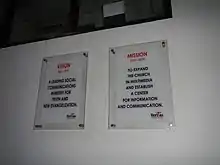
At dawn, Sunday, government troops arrived to knock down the main 50-kilowatt transmitter of Radio Veritas, cutting off broadcasts to people in the nearby provinces. The station switched to a 10-kilowatt standby transmitter with a limited range of broadcast.[65] The station was targeted because it had proven to be a valuable communications tool for the people supporting the rebels, keeping them informed of government troop movements and relaying requests for food, medicine, and supplies.[64]
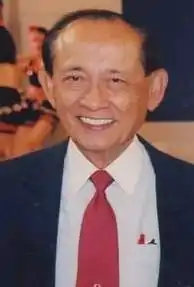
Still, people came to EDSA until it swelled to hundreds of thousands of unarmed civilians. The mood in the street was very festive, with many bringing whole families. Performers entertained the crowds, nuns and priests led prayer vigils, and people set up barricades and makeshift sandbags, trees, and vehicles in several places along EDSA and intersecting streets such as Santolan and Ortigas Avenue. Everywhere, people listened to Radio Veritas on their radios. A photo taken by Pete Reyes of Srs. Porferia Ocariza and Teresita Burias leading the rosary in front of soldiers has since become an iconic picture of the revolution.[66] Several groups sang Bayan Ko (My Homeland),[67] which, since 1980, had become a patriotic anthem of the opposition. People frequently flashed the 'LABAN' sign,[68] which is an "L" formed with their thumb and index finger. 'laban' is the Filipino word for 'fight', but also the abbreviation of Lakas ng Bayan, Ninoy Aquino's party. After lunch on February 23, Enrile and Ramos decided to consolidate their positions. Enrile crossed EDSA from Camp Aguinaldo to Camp Crame amidst cheers from the crowd.[64]
In the mid-afternoon, Radio Veritas relayed reports of Marines massing near the camps in the east and LVT-5 tanks approaching from the north and south. A contingent of Marines with tanks and armored vans, led by Brigadier General Artemio Tadiar, was stopped along Ortigas Avenue, about two kilometers from the camps, by tens of thousands of people.[69] Nuns holding rosaries knelt in front of the tanks and men and women linked arms together to block the troops.[70] Tadiar asked the crowds to make a clearing for them, but they did not budge. In the end, the troops retreated with no shots fired.[64]
By evening, the standby transmitter of Radio Veritas failed. Shortly after midnight, the staff was able to go to another station to begin broadcasting from a secret location under the moniker "Radyo Bandido" (Outlaw Radio, which is now known as DZRJ-AM). June Keithley, with her husband Angelo Castro, Jr., was the radio broadcaster who continued Radio Veritas' program throughout the night and in the ensuing days.[64]
More military defections
At dawn on Monday, February 24, the first serious encounter with government troops occurred. Marines marching from Libis, in the east, lobbed tear gas at the demonstrators, who quickly dispersed. Some 3,000 Marines then entered and held the east side of Camp Aguinaldo.[64]
Later, helicopters manned by the 15th Strike Wing of the Philippine Air Force, led by Colonel Antonio Sotelo, were ordered from Sangley Point in Cavite, south of Manila, to head to Camp Crame.[71] Secretly, the squadron had already defected and instead of attacking Camp Crame, landed in it, with the crowds cheering and hugging the pilots and crew members.[64]
A Bell 214 helicopter piloted by Major Deo Cruz of the 205th Helicopter Wing and Sikorsky S-76 gunships piloted by Colonel Charles Hotchkiss of the 20th Air Commando Squadron joined the rebel squadron earlier in the air. The presence of the helicopters boosted the morale of Enrile and Ramos who had been continually encouraging their fellow soldiers to join the opposition movement.[64] In the afternoon, Aquino arrived at the base where Enrile, Ramos, Reform the Armed Forces Movement (RAM) officers, and a throng were waiting.[71]
The capture of MBS-4
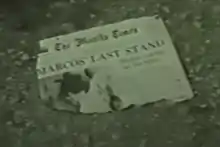
At around that time, June Keithley received reports that Marcos had left Malacañang Palace and broadcast this to the people at EDSA. The crowd celebrated and even Ramos and Enrile came out from Crame to appear to the crowds. The jubilation was however short-lived as Marcos later appeared on television on the government-controlled MBS-4,[72] (using the foreclosed ABS-CBN facilities, transmitter and compound in Broadcast Plaza, now ABS-CBN Broadcasting Center) declaring that he would not step down. It was thereafter speculated that the false report was a calculated move against Marcos to encourage more defections.[64]
During this broadcast, MBS-4 suddenly went off the air. A contingent of rebels, under Colonel Mariano Santiago, had captured the station. MBS-4 was put back on the air shortly after noon, with Orly Punzalan announcing on live television, "Channel 4 is on the air again to serve the people." By this time, the crowds at EDSA had grown to over a million, but some estimates place the crowd number up to 2 million people.[64]
On September 14, 1986, this broadcast was considered the "return" of ABS-CBN on air because this was the time when former employees of the network were inside the complex on after 14 years of closure since Marcos took it over during the Martial Law of 1972. "Radyo Bandido" ended broadcasting that afternoon, while Radio Veritas resumed transmissions, this time from the Broadcast Plaza's radio studios.
In the late afternoon, rebel helicopters attacked Villamor Airbase, destroying presidential air assets. Another helicopter went to Malacañang, fired a rocket, and caused minor damage. Later, most of the officers who had graduated from the Philippine Military Academy (PMA) defected. The majority of the Armed Forces had already changed sides.[64]
Marcos orders not to shoot
Prior dialogues to stop the revolution had not succeeded with the Armed Forces of the Philippines, which was led by Gen. Ver. AFP was ready to mount an airstrike on the day but Marcos ordered them to halt.[73][74]
The actual dialogue on TV between Marcos and then AFP Chief of Staff Gen. Ver went as follows:
Fabian Ver: The Ambush there is aiming to mount there in the top. Very quickly, you must immediately leave to conquer them, immediately, Mr. President.
Ferdinand Marcos: Just wait, come here.
Ver: Please, Your Honor, so we can immediately strike them. We have to immobilize the helicopters that they've got. We have two fighter planes flying now to strike at any time, sir.
Marcos: My order is not to attack. No, no, no! Hold on. My order is not to attack.
Ver: They are massing civilians near our troops and we cannot keep on withdrawing. You asked me to withdraw yesterday–
Marcos (interrupting): Uh yes, but ah... My order is to disperse without shooting them.
Ver: We cannot withdraw all the time...Marcos: No! No! No! Hold on! You disperse the crowd without shooting them.
Two inaugurations
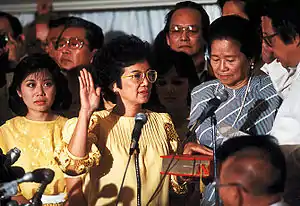 Corazon Aquino was inaugurated as the 11th president of the Philippines on February 25, 1986, at Sampaguita Hall (Now Kalayaan Hall). | |
| Date | February 25, 1986 |
|---|---|
| Location | Sampaguita Hall, Club Filipino, Greenhills, San Juan, Metro Manila |
| Participants | President of the Philippines, Corazon Aquino Assuming office Associate Justice of the Supreme Court of the Philippines,Claudio Teehankee Administering oath Vice President of the PhilippinesSalvador Laurel Assuming office Associate Justice of the Supreme Court of the Philippines,Vicente Abad Santos Administering oath |
On the morning of Tuesday, February 25, at around 7 a.m., a minor clash occurred between loyal government troops and the reformists. Snipers stationed atop the crony-owned RPN-9 transmitter in Panay Avenue, near MBS-4, began shooting at the reformists. Many rebel soldiers surged to the station,[64] and a rebel S-76 helicopter later shot the snipers at the broadcast tower. The troops later left after a V-150 was blocked by the crowd assembled.
Later in the morning, Corazon Aquino was inaugurated as President of the Philippines in a simple ceremony at Club Filipino[75] in Greenhills, about a kilometer from Camp Crame. She was sworn in as president by Senior Associate Justice Claudio Teehankee, and Laurel as vice-president by Justice Vicente Abad Santos. The Bible on which Aquino swore her oath was held by her mother-in-law Aurora Aquino, the mother of Ninoy Aquino. Attending the ceremonies were Ramos, who was then promoted to General, Enrile, and many politicians.[64]
Outside Club Filipino, all the way to EDSA, hundreds of people cheered and celebrated. Bayan Ko (My Country, a popular folk song and the unofficial National Anthem of protest) was sung after Aquino's oath-taking. Many people wore yellow, the color of Aquino's presidential campaign.
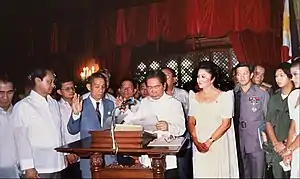
An hour later, Marcos held the inauguration at Malacañang Palace. Loyalist civilians attended the ceremony, shouting "Marcos, Marcos, Marcos pa rin! (Marcos, Marcos, still Marcos!)". On the Palace balcony, Marcos took the Oath of Office, aired on IBC-13 and RPN-9 (RPN-9 was going off-the-air during the broadcast of the inauguration, as its transmitter was captured by reformist soldiers)[64] None of the invited foreign dignitaries attended the ceremony, for security reasons. The couple finally emerged on the balcony of the Palace before 3,000 KBL loyalists who were shouting, "Capture the snakes!"[76] Rather tearfully,[76] First Lady Imelda Marcos gave a farewell rendition of the couple's theme song – the 1938 kundiman "Dahil Sa Iyo" (Because of You) – chanting the song's entreaties in Tagalog:
Because of you, I became happy
Loving I shall offer you
If it is true I shall be enslaved by you
All of this because of you.[76]
The broadcast of the event was interrupted as rebel troops successfully captured the other stations. It was the last time Marcos was seen in the Philippines.[64]
By this time, hundreds of people had amassed at the barricades along Mendiola, only a hundred meters away from Malacañang. They were prevented from storming the Palace by loyal government troops securing the area. The angry demonstrators were pacified by priests who warned them not to be violent.[64]
Marcos' departure
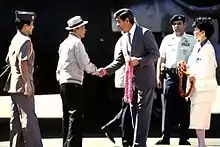
Despite holding an inauguration, Marcos and his family were already preparing to flee the country. At 5:00 a.m. on Tuesday morning, Marcos phoned United States Senator Paul Laxalt, asking for advice from the White House.[76] Laxalt advised him to "cut and cut clean", to which Marcos expressed his disappointment after a short pause. In the afternoon, Marcos talked to Minister Enrile, asking for safe passage for him, his family, and close allies such as General Ver.[77] He also asked Enrile if United States Ambassador Stephen Bosworth could assign a security escort for the Marcos family's departure.[78]
Around midnight, the Marcos family boarded a United States Air Force HH-3E Rescue helicopter[79] and flew to Clark Air Base in Angeles City 83 kilometers north of Manila. At Clark Air Base, Marcos asked to spend a couple of days with his family in Ilocos Norte, his native province. Aquino vetoed the request. President Reagan privately derided Aquino for denying Marcos a last look at his home province.[80]
The deposed First Family and their servants then rode US Air Force DC-9 Medivac and C-141B planes to Andersen Air Force Base in the north of the United States territory of Guam, then flying to Hickam Air Force Base in Hawaii where Marcos finally arrived on February 26. The United States Government documented that they entered the United States with millions of dollars in jewelry, gold, stocks, and cash.[10][64]
When news of the Marcos family's departure reached civilians, many rejoiced and danced in the streets. Over at Mendiola, the demonstrators stormed the Palace, which was closed to ordinary people for around a decade. Despite looting by some angry protesters, the majority wandered about inside through rooms where national history was shaped, looking at objects extravagant and mundane that the Marcos clan and its court had abandoned in their flight. Shortly after midnight on February 26, five army trucks of troops under the command of Fidel Ramos arrived in Malacañang Palace to secure it after Ferdinand Marcos had left - marking the end of the Marcos dictatorship, and placing the palace under the control of the Provisional Government of the Philippines until a new constitution could be enacted a year later, in 1987.[81]
In other countries, people also rejoiced and congratulated Filipinos they knew. CBS anchorman Bob Simon reported: "We Americans like to think we taught the Filipinos democracy. Well, tonight they are teaching the world."[64]
Aftermath
Immediately after her accession, Aquino issued Proclamation No. 3, a provisional constitution which established a revolutionary government. The edict promulgated the 1986 Freedom Constitution, which retained or superseded various provisions of the 1973 Constitution that were in force up to that point. This allowed Aquino to wield both executive and legislative powers; among her first acts was to unilaterally abolish the Batasang Pambansa (the unicameral legislature duly elected in 1984), pending a plebiscite for a more permanent Constitution and the establishment of a new Congress by 1987.[82]
Despite the return of democracy, President Aquino faced nine coup d'état attempts by RAM members or Marcos loyalists.
The revolution had an effect on democratization movements in such countries as Taiwan and South Korea; other effects include the restoration of the freedom of the press, abolition of repressive laws enforced by the previous regime, the adoption of the 1987 Constitution, and the subordination of the military to civilian rule, despite several coup attempts during Aquino's rule.[83]
The revolution provided for the restoration of democratic institutions after 13 years of totalitarian rule and these institutions has been used by various groups to challenge the entrenched political families and to strengthen Philippine democracy.[84]
Legacy

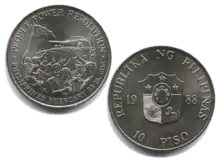
The People Power Revolution has inspired a call for a change of government through peaceful protests rather than bloodshed. Many similar revolutions have followed since then, taking the Philippine example of nonviolent regime change, such as that in East Germany and many other former Soviet Bloc countries, most of which had direct relation to the end of the Cold War in 1989.[85]
The EDSA Revolution Anniversary is a special public holiday in the Philippines. Since 2002, the holiday has been declared a special non-working holiday.[86][87]
Rampant corruption during the term of President Joseph Estrada led to the similar 2001 EDSA Revolution leading to his resignation from the presidency.
In 1986 a few months after February a music video starring various artists was released called, "Handog ng Pilipino Sa Mundo". It was written by Apo Hiking Society singer Jim Paredes and performed by numerous artists, and showed martial law heroes Jose W. Diokno, Lorenzo M. Tañada, Rene Saguisag, Butz Aquino, Joe Burgos, and Pres. Aquino with Vice-President Doy Laurel during their campaign.[88]
In 2003, the Radio Broadcast of the Philippine People Power Revolution was inscribed in the United Nations Educational, Scientific and Cultural Organization (UNESCO) Memory of the World Register, which is the official documentary heritage list of the United Nations (UN)'s educational and scientific body.[89]
In spite of the revolution's repudiation of Marcos' dictatorial regime, the Marcos family slowly regained a political presence in the Philippines mostly through what researchers attribute to a systematic spread of lies and disinformation,[90][91] with Imelda and her children Bongbong and Imee reacquiring positions in government by the 1990s. Bongbong himself was defeated as runner-up to Leni Robredo as a candidate for the Philippine vice presidency during the 2016 presidential elections. He protested in the Supreme Court and was denied multiple times, with the official gap getting even significantly larger from the original results.[92] In 2021, Bongbong announced his bid for the Philippine presidency in the 2022 Philippine presidential election.[93] He was elected president, marking the Marcos family's return to Malacañang after 36 years.[94][95]
See also
- Proclamation No. 1081
- 1972 Philippines Martial law under Ferdinand Marcos
- 1986 Philippine general election
- Epifanio de los Santos Avenue
- "Bayan Ko"
- "Handog ng Pilipino sa Mundo"
- "Magkaisa"
- EDSA Shrine
- People Power Monument
General:
- Timeline of the presidency of Ferdinand Marcos
Similar events:
- EDSA II
- EDSA III
- June Struggle, in the Republic of Korea
- Gdańsk Agreement of 1980 and Round Table Agreement of 1989, both induced by peaceful protests in Poland by Solidarity
- Tiananmen Square protests of 1989
- Fall of the Berlin Wall, in Germany
- Romanian Revolution
- Velvet Revolution, in Czechoslovakia
- 8888 Uprising, in Burma (now Myanmar)
- May 1998 riots of Indonesia
- Iranian Revolution
- Tunisian Revolution
- Egyptian Revolution of 2011
- 1991 Soviet coup d'état attempt
- 2013–2014 Cambodian protests
- 2021 Myanmar protests
Notes
- Other alternative names include the Philippine Revolution of 1986, EDSA 1986, EDSA I (pronounced EDSA One or EDSA Uno), People Power Revolution I and EDSA People Power.
References
- Sison, Jose Maria (February 24, 2006). "It was a convergence of various forces". Philippine Daily Inquirer. Retrieved August 4, 2014.
- Araullo, Carolina (March 2, 2000). "Left was at Edsa and long before". Philippine Daily Inquirer. Retrieved August 4, 2014.
- Suarez, Miguel (February 26, 1986). "Marcos' last days filled with errors and humiliation". The Evening Independent. Associated Press. Retrieved August 4, 2014.
She (Imelda) did not tell the crowd by that time all but a few thousand soldiers and officers, mostly those in the presidential guard, had by then turn against Marcos to join Mrs. Aquino's "people power" revolution
- "G.R. No. 88211". www.lawphil.net.
- Ileto, Reynold C. (June 1993). "The 'Unfinished Revolution' in Philippine Political Discourse". 東南アジア研究. 31 (1): 62–82. ISSN 0563-8682. Retrieved September 29, 2022.
- "G.R. No. L-82380 April 29, 1988 - AYER PRODUCTIONS PTY. LTD., ET AL. v. IGNACIO M. CAPULONG, ET AL. : April 1988 - Philippine Supreme Court Decisions". www.chanrobles.com.
- "Speech of President Corazon Aquino on the EDSA Flag Raising, February 25, 1987 | GOVPH".
- The "Yellow Revolution": Its Mixed Historical Legacy
- "The Original People Power Revolution". QUARTET p. 77. Archived from the original on February 15, 2008. Retrieved February 28, 2008.
- Kumar, Ravindra (2004), Mahatma Gandhi at the Close of Twentieth Century, Anmol Publications PVT. LTD., p. 168, ISBN 978-81-261-1736-9, retrieved December 2, 2007.
- "Edsa people Power 1 Philippines". Angela Stuart-Santiago. Archived from the original on December 13, 2007. Retrieved December 3, 2007.
- Lacsamana 1990, p. 187
- Kessler, Richard John (1989). Rebellion and repression in the Philippines. New Haven: Yale University Press. p. 43. ISBN 978-0300044065. OCLC 19266663.
- Daniel Cassman (August 14, 2015). "Moro National Liberation Front". Mapping Militant Organizations – Stanford university.
- "Declaration of Martial Law". Official Gazette of the Republic of the Philippines.
{{cite web}}: CS1 maint: url-status (link) - Celoza, Albert (1997), Ferdinand Marcos and the Philippines: the political economy of authoritarianism, Greenwood Publishing Group
- "Ninoy linked up with the Left to aid presidential ambition". GMA News. August 18, 2010. Archived from the original on February 7, 2015.
- "JOSUE JAVELLANA, petitioner, vs. THE EXECUTIVE SECRETARY, THE SECRETARY OF NATIONAL DEFENSE, THE SECRETARY OF JUSTICE AND THE SECRETARY OF FINANCE, respondents". March 31, 1973.
- "Max Soliven recalls Ninoy Aquino: Unbroken". Philippines Star. October 10, 2008. Archived from the original on October 16, 2013. Retrieved August 30, 2013.
- Solis, Rolando M. (August 21, 2011). "Heart-to-heart talks with Ninoy".
- "Aquino, Corazon Cojuangco • The Ramon Magsaysay Award Foundation • Honoring greatness of spirit and transformative leadership in Asia". rmaward.asia. Archived from the original on August 4, 2017. Retrieved January 11, 2019.
- "A look back at Ninoy Aquino's murder". Philippine Star. August 20, 2014. Archived from the original on August 28, 2016. Retrieved March 30, 2016.
- "Services – INQUIRER.net". Archived from the original on May 16, 2006.
- Gavilan, Jodesz (August 20, 2021). "LOOK BACK: The Aquino assassination". Rappler. Retrieved July 6, 2021.
{{cite web}}: CS1 maint: url-status (link) - Javate-De Dios, Aurora; Bn Daroy, Petronilo; Kalaw-Tirol, Lorna, eds. (1988), Dictatorship and Revolution: Roots of People's Power, Conspectus Foundation Incorporated, p. 132, ISBN 9789919108014, OCLC 19609244, archived from the original on October 17, 2015
- Schock, Kurt (2005), "People Power Unleashed: South Africa and the Philippines", Unarmed Insurrections: People Power Movements in Nondemocracies, University of Minnesota Press, p. 56, ISBN 978-0-8166-4192-5
- "Lakas Ng Bayan: The People's Power/EDSA Revolution 1986". University of Alberta, Canada. Archived from the original on August 8, 2007. Retrieved December 10, 2007.
- Galang, Ping (February 21, 2011). "The economic decline that led to Marcos' fall". GMA News and Public Affairs. Retrieved February 18, 2019.
- Guido, Edson Joseph; de los Reyes, Che (2017), "The best of times? Data debunk Marcos' economic 'golden years'", ABSCBN News and Public Affairs
- Galang, Ping (September 21, 2009). "Martial law: costly lessons in economic development". GMA News Online. Retrieved September 25, 2020.
- Punongbayan, JC (September 11, 2017). "Marcos plundered to 'protect' the economy? Makes no economic sense". Rappler. Ortigas Center, Pasig.
- Magno, Alexander R., ed. (1998). "Democracy at the Crossroads". Kasaysayan, The Story of the Filipino People Volume 9:A Nation Reborn. Hong Kong: Asia Publishing Company Limited.
- ""Government is always and only an instrument of the people."—Jose W. Diokno". February 26, 2018.
- Kimura, Masataka (2019). "Martial Law and the Realignment of Political Parties in the Philippines (September 1972-February 1986): With a Case in the Province of Batangas" (PDF).
- Lane, Max R. (1990). "The Urban Mass Movement in the Philippines, 1983-87" (PDF).
- "APPENDIX: A HISTORY OF THE PHILIPPINE POLITICAL PROTEST".
- "Election developments in the Philippines – President Reagan's statement – transcript". US Department of State Bulletin, April 1986. 1986. Retrieved December 3, 2007.
- Zunes, Stephen; et al. (1999), Nonviolent Social Movements: A Geographical Perspective, Blackwell Publishing, p. 129, ISBN 978-1-57718-076-0, retrieved December 3, 2007
- Steinberg, David Joel (2000), The Philippines: Colonialism, collaboration, and resistance, Basic Books, p. 144
- Henares, Larry Jr. (March 2–3, 1987). "Pepe Diokno, when comes such another?".
- "AQUINO'S WIDOW SEEKS TO UNITE MARCOS FOES". The New York Times. December 16, 1984.
- "LOOKING BEYOND MARCOS". The New York Times. January 8, 1984.
- "MARCOS FOES ANNOUNCE UNITY PLATFORM". The New York Times. December 27, 1984.
- Williams, Nick B. Jr. (November 9, 1985). "Marcos Foes Striving for United Front". Los Angeles Times.
- Ackerman, Peter; Duvall, Jack (October 5, 2001). A Force More Powerful: A Century of Non-Violent Conflict. ISBN 9780312240509.
- Peter Ackerman; Jack DuVall (2001), A Force More Powerful: A Century of Nonviolent Conflict, Macmillan, p. 384, ISBN 978-0-312-24050-9;
^ Isabelo T. Crisostomo (1987), Cory—profile of a president, Branden Books, p. 193, ISBN 978-0-8283-1913-3 (showing a reproduction of NAMFREL's announcement of the results). - "iReport EDSA 20th Anniversary Special Issue | Dr. William Castro". Philippine Center for Investigative Journalism, February 2006. Archived from the original on January 20, 2008. Retrieved January 16, 2008.
- Santos, Reynaldo Jr. (February 26, 2013). "1986 Comelec walkout not about Cory or Marcos". Rappler. Archived from the original on February 28, 2016. Retrieved January 12, 2016.
- "POST-ELECTION STATEMENT". Archived from the original on September 23, 2015. Retrieved March 15, 2015.
- Hoffman, David; Cannon, Lou; Coleman, Milton; Dewar, Helen; Goshko, John M.; Oberdorfer, Don; W, George C. (February 26, 1986). "In Crucial Call, Laxalt Told Marcos: 'Cut Cleanly'". The Washington Post. Archived from the original on August 22, 2016.
- "PRESIDENT'S STATEMENT, FEB. 11, 1986". US Department of State Bulletin, April 1986. 1986. Retrieved December 3, 2007.
- Schock, Kurt (2005), Unarmed Insurrections: People Power Movements in Nondemocracies, U of Minnesota Press, p. 77, ISBN 978-0-8166-4193-2, retrieved December 3, 2007.
- "The Fall of Dictatorship". Official Gazette. Retrieved July 8, 2022.
- "Speech of President Aquino at the anniversary of Tagumpay ng Bayan, February 16, 2012 (English translation)". Official Gazette of the Republic of the Philippines. Retrieved May 18, 2021.
{{cite web}}: CS1 maint: url-status (link) - Schock, Kurt (1999). "People Power and Political Opportunities: Social Movement Mobilization and Outcomes in the Philippines and Burma". Social Problems. 46 (3): 355–375. doi:10.2307/3097105. ISSN 0037-7791. JSTOR 3097105.
- Cruz, Elfren S. "The road to EDSA". Philstar.com. Retrieved May 18, 2021.
- Vitug, Marites Dañguilan; Almonte, Jose T. (February 23, 2015). "Transfer power to the people". Philippine Daily Inquirer. Retrieved August 20, 2021.
- Fineman, Mark (February 27, 1986). "The 3-Day Revolution: How Marcos Was Toppled". Los Angeles Times.
- Cepeda, Mara (October 12, 2015). "10 things to know about Gringo Honasan".
- West, Lois A. (1997), Militant Labor in the Philippines, Temple University Press, pp. 19–20, ISBN 978-1-56639-491-8, retrieved December 3, 2007.
- "Day One (EDSA: The Original People Power Revolution by Angela Stuart-Santiago)". Archived from the original on August 7, 2015. Retrieved March 15, 2015.
- Video on YouTube
- "What was Edsa?". February 25, 2016.
- Paul Sagmayao, Mercado; Tatad, Francisco S. (1986), People Power: The Philippine Revolution of 1986: An Eyewitness History, Manila, Philippines: The James B. Reuter, S.J., Foundation, OCLC 16874890
- McCargo, Duncan (2003), Media and Politics in Pacific Asia, Routledge, p. 20, ISBN 978-0-415-23375-0, retrieved December 3, 2007
- "Be a Keeper of the EDSA Flame". Inquirer.net. INQUIRER.net. 2016. Retrieved November 8, 2020.
- Taylor, Robert H. (2002), The Idea of Freedom in Asia and Africa, Stanford University Press, p. 210, ISBN 978-0-8047-4514-7, retrieved December 3, 2007.
- Crisostomo, Isabelo T. (1987), Cory, Profile of a President: The Historic Rise to Power of Corazon, Branden Books, p. 217, ISBN 978-0-8283-1913-3, retrieved December 3, 2007.
- Lizano, Lolita (1988), Flower in a Gun Barrel: The Untold Story of the Edsa Revolution, L.R. Lizano, retrieved December 2, 2007.
- Merkl, Peter H. (2005), The Rift Between America And Old Europe: the distracted eagle, Routledge, p. 144, ISBN 978-0-415-35985-6, retrieved December 2, 2007.
- Crisostomo, Isabelo T. (April 1, 1987), Cory, Profile of a President: The Historic Rise to Power of Corazon, Branden Books (published 1987), p. 226, ISBN 978-0-8283-1913-3, retrieved December 3, 2007.
- Maramba, Asuncion David (1987), On the Scene: The Philippine Press Coverage of the 1986 Revolution, Solar publishing Corp., p. 27, ISBN 978-971-17-0628-9, retrieved December 3, 2007.
- Branigin, William (February 24, 1986). "Rebels, Marcos Contest Control of Philippines". Washington Post. Archived from the original on June 3, 2021. Retrieved June 14, 2021.
- Alejandrino, Jose (November 24, 2015). Journal of an Unknown Knight. Flipside Digital Content Company Inc. ISBN 978-621-01-0084-6. Retrieved June 14, 2021.
- Crisostomo, Isabelo T. (April 1, 1987), Cory, Profile of a President: The Historic Rise to Power of Corazon, Branden Books, p. 257, ISBN 978-0-8283-1913-3, retrieved December 3, 2007.
- Ellison, Katherine (2005), Imelda: Steel Butterfly of the Philippines, iUniverse, p. 244, ISBN 978-0-595-34922-7, retrieved December 3, 2007.
- Brands, H W (2015). Reagan: the life. New York: Doubleday. ISBN 9780385536400. Archived from the original on January 5, 2016.
- Joaquin, Nick (1986). The Quartet of the Tiger Moon: Scenes from the People-Power Apocalypse. Book Stop. p. 90. ISBN 971-8523-00-6.
- Halperin, Jonathan J. (1987), The Other Side: How Soviets and Americans Perceive Each Other, Transaction Publishers, p. 63, ISBN 978-0-88738-687-9, retrieved December 3, 2007.
- Karnow, Stanley (March 19, 1989). "REAGAN AND THE PHILIPPINES: Setting Marcos Adrift". The New York Times. Archived from the original on January 11, 2017. Retrieved February 11, 2017.
- "Archived copy". www.nytimes.com. Archived from the original on May 24, 2015. Retrieved August 1, 2022.
{{cite web}}: CS1 maint: archived copy as title (link) - Joaquin G. Bernas (1995). The Intent of the 1986 Constitution Writers. Manila, Philippines: Rex Book Store. pp. 2–4.
- McGeown, Kate (February 25, 2011). "People Power at 25: Long road to Philippine democracy". BBC.co.uk. Archived from the original on February 26, 2011. Retrieved February 25, 2011.
- Putzel, James (Spring 1999), "Survival of an imperfect democracy in the Philippines", Democratization, 6 (1): 198–223, doi:10.1080/13510349908403603.
- "Comment: Remembering the Philippine's People Power Revolution". Archived from the original on December 21, 2016. Retrieved May 16, 2017.
- Proclamation No. 295: Declaring 2012 National Holidays Archived January 17, 2013, at the Wayback Machine, December 12, 2011, Official Gazette of the Philippines
- "Proclamation No. 1841" (PDF). Philippine Labor Laws. July 21, 2009. Archived (PDF) from the original on October 10, 2017.
- Sicam, Ed (February 26, 2011). "'Handog ng Pilipino sa Mundo' was composed in three minutes".
- "Radio Broadcast of the Philippine People Power Revolution | United Nations Educational, Scientific and Cultural Organization". UNESCO. Archived from the original on August 24, 2015.
- Whaley, Floyd (February 23, 2016). "30 Years After Revolution, Some Filipinos Yearn for 'Golden Age' of Marcos". The New York Times. Manila. Retrieved December 26, 2020.
But in the decades since Marcos was ousted and fled the country, the outrage has faded for many Filipinos. Despite the accusations of widespread corruption and human rights violations, none of the Marcos family members have been jailed. The family has quietly returned to politics — Mrs. Marcos is a now member of Congress, while her daughter Imee Marcos is a governor.
- Berdoz, Enrico (December 12, 2020). "Propaganda web: Pro-Marcos literature, sites, and online disinformation linked". ABS-CBN News. Retrieved February 24, 2022.
- Tomacruz, Sofia (October 18, 2019). "Robredo widens lead over Marcos in recount in 3 pilot provinces".
- "Marcos declares presidential bid". Manila Standard. October 6, 2021. Retrieved December 29, 2021.
- Cabato, Regine; Westfall, Sammy (May 10, 2022). "Marcos family once ousted by uprising wins Philippines vote in landslide". Washington Post. Retrieved June 5, 2022.
- Ratcliffe, Rebecca (May 9, 2022). "Ferdinand Marcos Jr triumphs in Philippines presidential election". The Guardian. Retrieved June 5, 2022.
Bibliography
- Baron, Cynthia S. and Suazo, Melba M. Nine Letters: The Story of the 1986 Filipino Revolution. Quezon City, Philippines. Gerardo P. Baron Books. 1986.
- Bello, Walden. "From the ashes: The rebirth of the Philippine revolution—a review essay." Third World Quarterly 8.1 (1986): 258-276. online
- Johnson, Brian. The Four Days of Courage: The Untold Story of the People Who Brought Marcos Down. Toronto, Canada. McClelland and Stewart, 1987.
- Lacsamana, Leodivico Cruz (1990). Philippine History and Government (Second ed.). Phoenix Publishing House, Inc. ISBN 971-06-1894-6.
- Mendoza, Amado, '"People Power" in the Philippines, 1983–86', in Adam Roberts and Timothy Garton Ash (eds.), Civil Resistance and Power Politics: The Experience of Non-violent Action from Gandhi to the Present, Oxford: Oxford University Press, 2009. ISBN 978-0-19-955201-6. US edition. On Google.
- Mercado, Paul Sagmayao, and Tatad, Francisco S. People Power: The Philippine Revolution of 1986: An eyewitness history. Manila, Philippines. The James B. Reuter, S.J., Foundation. 1986.
- Schock, Kurt. Unarmed Insurrections: People Power Movements in Nondemocracies. Minneapolis, USA. University of Minnesota Press. 2005.
External links
- John Nery (writer) (2006). Edsa 20 ‘Isang Larawan’—An Inquirer documentary [EDSA 20 An Illustration] (documentary) (in Filipino). Philippines: Philippine Daily Inquirer. Retrieved March 2, 2021.
- R.A. Rivera (director) (2015). People Power @ 30 - History (documentary, episode of History with Lourd) (in Filipino). Philippines: TV5 Network. Retrieved March 2, 2021.
- People Power Revolution Day by Day (in English and Filipino). 2021. Retrieved March 2, 2021.
.jpg.webp)



